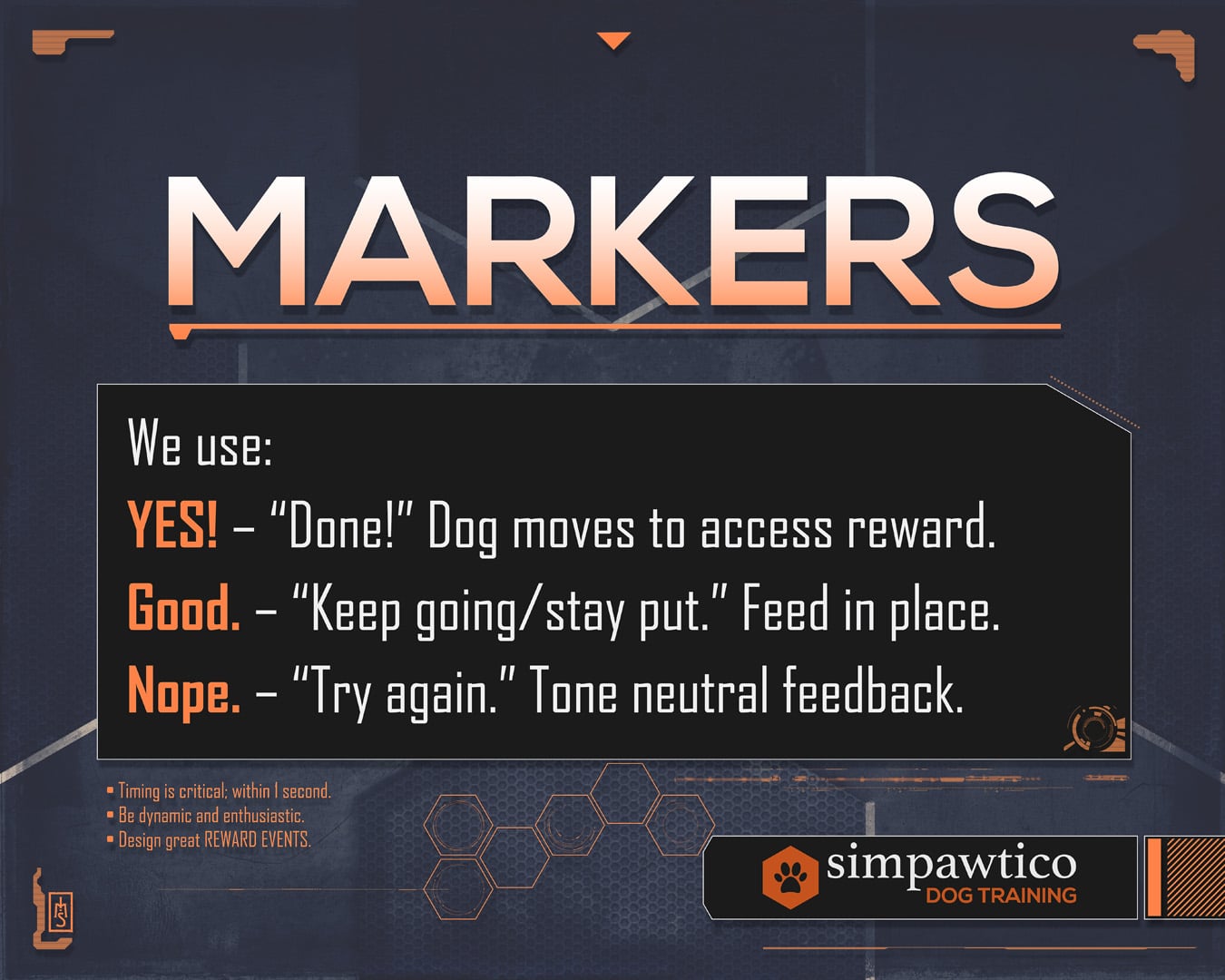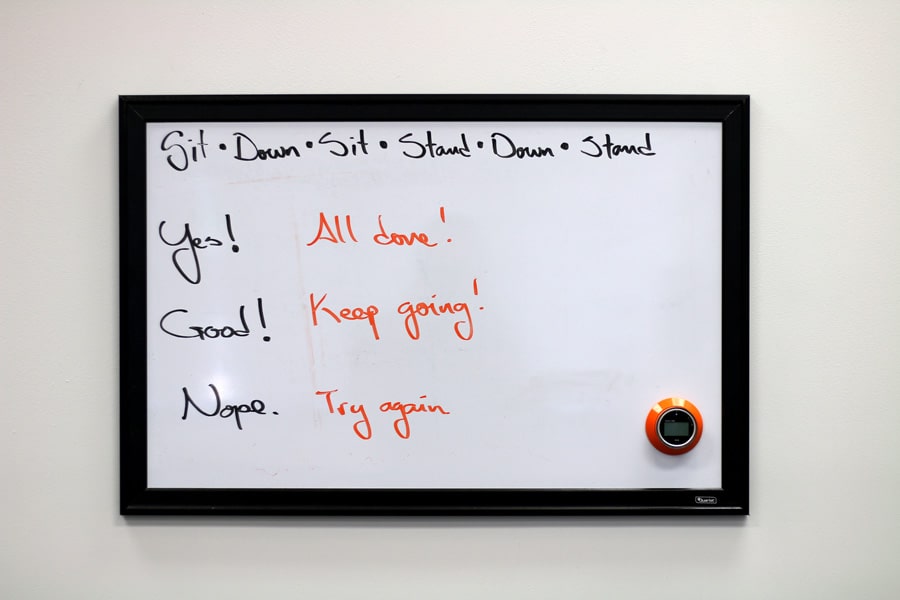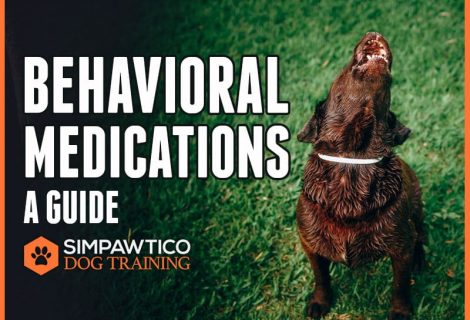Using Marker Training – Using your Voice for Great Feedback!
Many times in my videos and blogs, I’ve said that your voice is your #1 training tool. Today we’re going to go over the hows and whys of it so we can level up in your work with your dog.
IT’S ABOUT TO GET TECHNICAL
To date, this will be one of the most technical posts I’ve done. I usually try to avoid being too technical because I feel like that stuff is for me to know to do my job. Most dog owners don’t need to know all of it, and many don’t care to, which is fine. That’s why I always try to explain things in the simplest terms possible so that I can make them as accessible to as many people as I can.
Today, I think knowledge about how and why the pieces work together will help you put together a more robust set of tools in your practice arsenal.
THREE KEY CHARACTERISTICS
I have said many times that your voice is your #1 training tool. I repeat that mantra ALL THE TIME in my training classes and in my private sessions. It’s actually one of our Master Keys. According to world-renowned trainer, behaviorist, and veterinarian Dr. Ian Dunbar, your feedback needs to be three things:
- Ongoing
- Binary
- Analog
It has to be a running commentary on the dog’s performance. Most owners do not do this. Most owners take the good for granted and piss and moan about the bad…if they say anything at all, so the dog is left to guess at what they’re supposed to be doing. That means our feedback must also communicate what they’ve done right as much or more as what they’ve done incorrectly. And it has to be representative. Feedback must be analogous to their effort and performance. Great effort gets great feedback, mediocre effort gets lukewarm feedback, and poor effort gets the appropriate response based on what they are doing IN THAT MOMENT.
Now, most of the time, we can be fairly conversational with our dogs. Although dogs don’t process language, they generally get the gist of what we are saying through our tone, volume, and body language and memorizing the meanings of certain chains of sounds—words and phrases. This is how they learn the meanings of sounds like their name, as well as requests and phrases like “Do you wanna go on a walk?” and “Let’s get in the car!” However, we have to narrow our focus while in teaching and practice mode. In the last post, I quoted educator Harry Wong when he said:
“The greater the structure of a lesson and the more precise the directions on what to do, the lower the error rate and the higher the achievement rate.”
For dog owners, this means that when we work with our dogs, we must communicate clearly, efficiently, and precisely. We do that through effective feedback, and a big piece of that is using markers. Let’s go over this, so you understand how we’re working here:
WHAT IS A MARKER?
Also called a bridge, or more technically, a “bridging stimulus.” For Operant Conditioning to work, the result of an action—whether that’s a reward or a consequence—must come within about a second from the time the action happens. Well, this isn’t always possible. So, a marker forms a bridge between performing the action and the result.
If your dog is taught what a marker means, and the marker comes within that one-second window, then it will extend that time somewhat, and operant conditioning can still occur. This means, though, that timing is super important. We must give the dog a mark or bridge within 1 second to connect it with what they did. That’s “One Mississippi” or “One-one-thousand.” No more. The faster, the better, and this takes practice. This is probably the hardest thing for people to get right. If you wait longer than 1 second, your dog will think you mean something else.
OK, so now that we’re beginning to understand markers, let’s see how they work.
TERMINAL MARKER
Sometimes called a Terminal Bridge or an Event Marker. This communicates to the dog that they’ve just done what we wanted them to do. For this, I say, “Yes!” If you’re a clicker trainer, your click is the terminal marker.
If you’re working with deaf dogs, you may use a penlight, a hand signal, or a touch. Terminal markers also become conditioned over time to be secondary reinforcers. This means that they become somewhat rewarding in and of themselves.
INTERMEDIATE MARKER
Sometimes called a Support Bridge. This communicates to the dog, “Keep going.” I want the dog to know they’re doing well, but they’re not quite done yet. Think of it like breadcrumbs for the dog to follow. For this, I use “Good.”
NO-REWARD MARKER
This communicates to the dog, “try again.” This is not a correction or a reprimand; it’s simply feedback, it’s information. Remember that Dr. Dunbar said that feedback needs to be Binary. For this, I use “Nope.”
Let me emphasize: No-Reward Markers are NOT used like reprimands or corrections. It’s tone-neutral feedback. Imagine teaching your young nephew how to play a board game. That’s the tone you’re going to use most of the time. It’s encouraging, and we want them to enjoy the process.
Studies have shown that they can seriously impede learning if you use NRMs too much, or you use them like a reprimand with a frustrated or angry tone. They flatten out the learning curve and can discourage your dog from trying. In fact, I recommend that in the beginning phases of teaching something new, you should make a conscious effort to use as few NRMs as possible. We have to streamline that initial learning. Once we’ve gotten over the hump, though, we can use it to help make those tiny course corrections that steer improvement toward higher achievement.
TONE & VOLUME
This is an underused strategy to use with your markers. Remember that effective feedback should be analog. We can communicate much of that with tone and volume. While NRMs should be tone/volume neutral, your terminal and intermediate markers can and should have some effect on communicating more data to your dog. This means that doing something they’ve done often will get a “Yes.” But doing something difficult for the first time may get a “YES!!!” Same with good.
MARKER PRO TIPS
Here are some PRO TIPS to help you sew up your voice work and Marker Training
- Requests should be made tone and volume neutral. Then we can use tone and volume as a component of our Analog feedback.
- Only use your Terminal Marker ONE TIME. Don’t get excited and say, “Yes! Yes! Yes!” This will confuse your dog.
- You can say whatever you want AFTER your Terminal Marker. You can say, “Good dog,” or “You rock,” or “Very nice.” That momentary engagement with the request is over so everything up until the next request is just gravy.
- Your Intermediate marker is adaptable and fluid based on what and how you’re working. That’s why in the examples, you hear me say, “Good,” “Good boy,” “Good job,” “Good Stay,” etc. As long as your dog hears “Good,” you bring them along.
- And the last pro-tip is to…
CUSTOMIZE YOUR ENERGY
You do have to tailor your training strategy and energy to your dog, though. Temperament plays a role in this. For example, some dogs, especially adolescent dogs, will get too jazzed up if you’re too exuberant with them, which makes practice difficult. These dogs might need a nice, calm tone. Likewise, some dogs with a low drive or low confidence may NEED you to be exuberant. My Jack Russell, Darwin, does not have a high drive in practice, and consequently, I have to be his cheerleader on cocaine.
He also cannot handle NRMs well because he has low frustration tolerance. With him, I have to be super enthusiastic with the praise and ignore mistakes or he’ll start to shut down and wander away, all dejected. On the other hand, my late Boston Terrier, Bobo, could take whatever I threw at him all day. He had high frustration tolerance, was passionate about working together, and wanted to figure it out. He would go and go and go until he got it right, no matter what kind of tone I used or how many NRMs I used. And when he nailed it and got the big praise, he was over the moon, ready for more.
So, you must make your training energy fit your dog. Your dog’s drive, temperament, and skill level will determine how you proceed.
CULTIVATING A PROBLEM SOLVER
However you do it, though, one of the ultimate goals in working with a dog is to turn them into a problem-solver. We don’t want to create robots that follow commands. These are intelligent and sensitive living things. I want a dog that sees training situations as fun puzzles. I love watching a dog trying things out when they’re learning something new and working through it. Too many owners and trainers just make dogs do things. Shouldn’t we encourage dogs to use their brains?
To me, when I’m working with a dog, the number of times they “comply” isn’t nearly as important as getting that “Ohhhhhhh, I get it!” And then watching them progress like lightning. That is how you get a dog that happily does what you ask. For my money, impulse control, problem-solving, and the ability to work through stress are vital skills every dog needs to learn. Life is full of consequences, pressure, and not always getting what you want. Teaching your dog to cope with failure and continue trying is a powerful life skill.
LET’S RECAP THE SYSTEM
 So let’s go back to our original conditions. Feedback must be Ongoing, Binary, and Analog. So, we use the various bridges to give the dog a running commentary. We use the bridges to make the feedback binary; it’s not a guessing game, and we use our tone and volume to make it analog; that is to say, it is analogous with their efforts and representative of how they’re doing at that moment.
So let’s go back to our original conditions. Feedback must be Ongoing, Binary, and Analog. So, we use the various bridges to give the dog a running commentary. We use the bridges to make the feedback binary; it’s not a guessing game, and we use our tone and volume to make it analog; that is to say, it is analogous with their efforts and representative of how they’re doing at that moment.
An interesting side effect of using markers in a positive reinforcement, reward-based system is that you also get some neat Classical Conditioning. We know that operant and classical conditioning are inseparable, and also both happen everywhere all of the time. So, by using the markers, we are pairing an auditory cue with a reward. This allows us to create emotional triggers and cues that can be used without treats or tangible rewards. We can start small and build up from there – if the dog knows that he will get rewarded when he hears the marker, they will naturally start associating warm and fuzzy feelings with the marker. Just hearing the marker begins to carry some reward along with it.
By using positive reinforcement, reward-based training, and markers effectively, we can create strong emotional connections with our dogs that will equip them for a lifetime of learning. We can rewire their brains for success and ensure they always want to learn. The more we build up those positive associations, the more motivated our dogs will be to please us and learn new tricks.
FIND OR ADAPT A SYSTEM FOR YOU
Now, as I showed you, I use “Yes,” “Good,” and “Nope,” and I’m certainly not the only trainer that does. However, at the end of the day, you could technically use anything for your markers as long as you’re consistent. Some animal behaviorists prefer hard, simple sounds like “X” and “D.” If you’re a clicker trainer, you primarily use the clicker instead of vocal markers. And to complicate things, there are many different schools of thought on this. If you ask thirteen different trainers, you’ll get thirteen different answers. I am certainly not presenting this as the ONLY way to get the job done, but it works for me, and my students like it.
Mainly you should understand the mechanics and then put them into practice in a way that makes sense to you and fits your personality. You should ask yourself, “Does the technique resonate with me?” If it does not, it’s not going to work in your practice anyways because your heart’s not in it. You’ll give mediocre effort, which means you’ll probably get mediocre results. I encourage you to explore and find a system the resonates with you and that YOU can work with. Ultimately, that will work the best for you and your dog. And look: if this is new to you, you’re going to mess it up. Keep at it, and seek help from a qualified trainer for some of your more challenging situations.
ASK AWAY…
All right, guys, QUESTIONS for you: how do you use markers in your training, and what markers do you prefer? And what other questions do you have? Let’s connect in the comment section. Next time I’ll talk about one of my favorite subjects, the Positive Training Trifecta.
In the meantime, don’t forget to give the video above a thumbs up, and as always: keep learning, keep practicing, and we’ll see you next time. Thanks for looking!
RESOURCES
There are TONS of articles about using your voice and markers (or bridges). Here are three I really love:
-
“Barking up the Wrong Tree” article by Dr. Ian Dunbar. This great article goes into much more depth than my video and even covers other tidbits like Instructive Reprimands and using the food correctly.
-
Syn Alia Training Systems with Kasey Cover. Kasey Cover has been training animals since 1973. There is some great info and freebies if you poke around enough!
-
“The Power of Training Dogs with Markers” by Ed Frawley of Leerburg. This is a pretty long and technical article, but it is very thorough. There are a few hiccups where incorrect terminology is used, and there are some bits I do differently, but that’s just splitting hairs; it’s a hell of an article, and you will learn a lot from it.










This article changed my life when training became really tough for myself and my puppy in 2017.